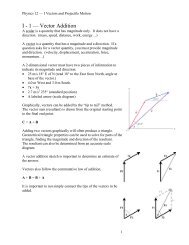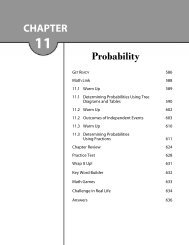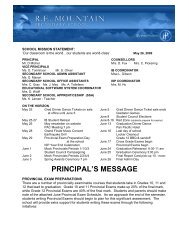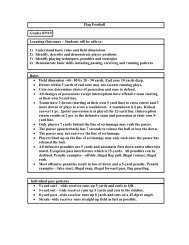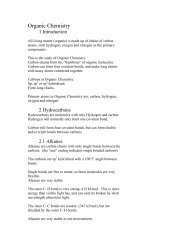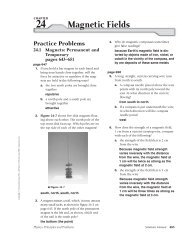Ch 12 Answers
Ch 12 Answers
Ch 12 Answers
Create successful ePaper yourself
Turn your PDF publications into a flip-book with our unique Google optimized e-Paper software.
<strong>Ch</strong>apter <strong>12</strong> continued<br />
75. Analyze and Conclude During a game,<br />
the metabolism of basketball players often<br />
increases by as much as 30.0 W. How much<br />
perspiration must a player vaporize per<br />
hour to dissipate this extra thermal energy?<br />
The amount of thermal energy to<br />
be dissipated in 1.00 h is<br />
U (30.0 J/s)(3600 s/h) 1.0810 5 J.<br />
The amount of water this energy,<br />
transmitted as heat, would vaporize is<br />
m <br />
<br />
Q<br />
HV<br />
1.0810 5 J<br />
<br />
2.2610 6 J/kg<br />
0.0478 kg<br />
76. Analyze and Conclude <strong>Ch</strong>emists use<br />
calorimeters to measure the heat produced<br />
by chemical reactions. For instance, a<br />
chemist dissolves 1.010 22 molecules of a<br />
powdered substance into a calorimeter containing<br />
0.50 kg of water. The molecules<br />
break up and release their binding energy to<br />
the water. The water temperature increases<br />
by 2.3°C. What is the binding energy per<br />
molecule for this substance?<br />
The amount of energy added to the<br />
water is<br />
U mCT<br />
(0.50 kg)(4180 J/kg°C)(2.3°C)<br />
4.8 kJ<br />
The energy per molecule is therefore,<br />
4.8 kJ<br />
<br />
10 22 molecules<br />
4.810 19 J/molecule<br />
77. Apply Concepts All of the energy on Earth<br />
comes from the Sun. The surface temperature<br />
of the Sun is approximately 10 4 K.<br />
What would be the effect on our world if<br />
the Sun’s surface temperature were 10 3 K?<br />
Student answers will vary. <strong>Answers</strong><br />
should reflect changing average<br />
temperature on Earth, different weather<br />
patterns, plant and animal species<br />
dying out, etc.<br />
Writing in Physics<br />
page 338<br />
78. Our understanding of the relationship<br />
between heat and energy was influenced by a<br />
soldier named Benjamin Thompson, Count<br />
Rumford; and a brewer named James Prescott<br />
Joule. Both relied on experimental results to<br />
develop their ideas. Investigate what experiments<br />
they did and evaluate whether or not<br />
it is fair that the unit of energy is called the<br />
Joule and not the Thompson.<br />
In 1799, heat was thought to be a liquid<br />
that flowed from one object to another.<br />
However, Count Rumford thought that<br />
heat was caused by the motion of particles<br />
in the metal cannon. He did not do<br />
any quantitative measurements and his<br />
ideas were not widely accepted. In 1843,<br />
Joule, doing careful measurements,<br />
measured the change in temperature<br />
caused by adding heat or doing work<br />
on a quantity of water. He proved that<br />
heat is a flavor of energy and that energy<br />
is conserved. Joule deserves the<br />
credit and the eponymic unit.<br />
79. Water has an unusually large specific heat<br />
and large heats of fusion and vaporization.<br />
Our weather and ecosystems depend upon<br />
water in all three states. How would our<br />
world be different if water’s thermodynamic<br />
properties were like other materials, such as<br />
methanol?<br />
The large specific heat and large heats<br />
of fusion and vaporization mean that<br />
water, ice, and water vapor can store a<br />
lot of thermal energy without changing<br />
their temperatures too much. The implications<br />
are many. The oceans and large<br />
lakes moderate the temperature<br />
changes in nearby regions on a daily<br />
and seasonal basis. The day-to-night<br />
temperature variation near a lake is<br />
much smaller than the day-to-night<br />
temperature variation in the desert. The<br />
large heat of fusion of water controls<br />
the change of seasons in the far north<br />
and south. The absorption of energy by<br />
freezing water in the fall and its release<br />
284 Solutions Manual Physics: Principles and Problems<br />
Copyright © Glencoe/McGraw-Hill, a division of The McGraw-Hill Companies, Inc.









